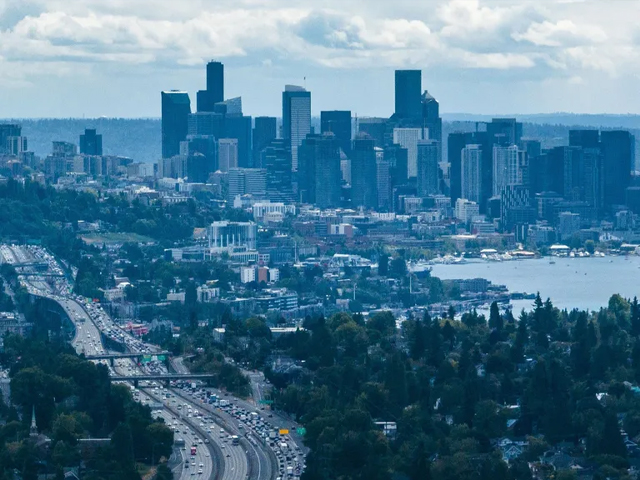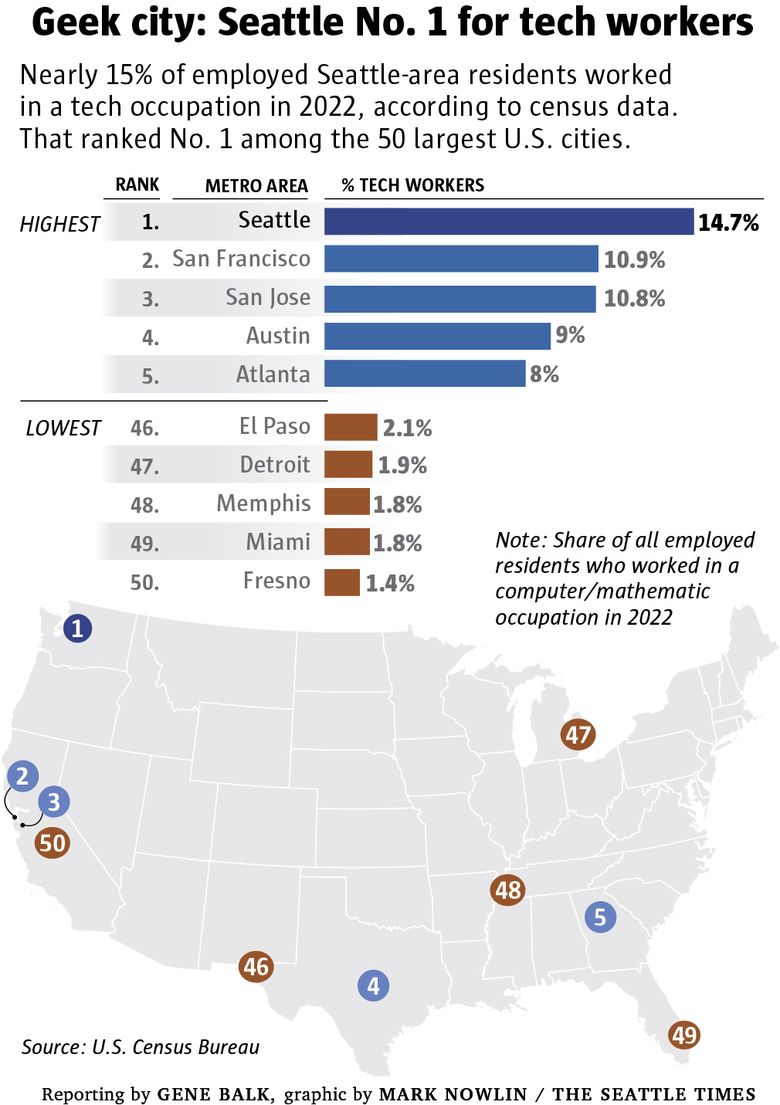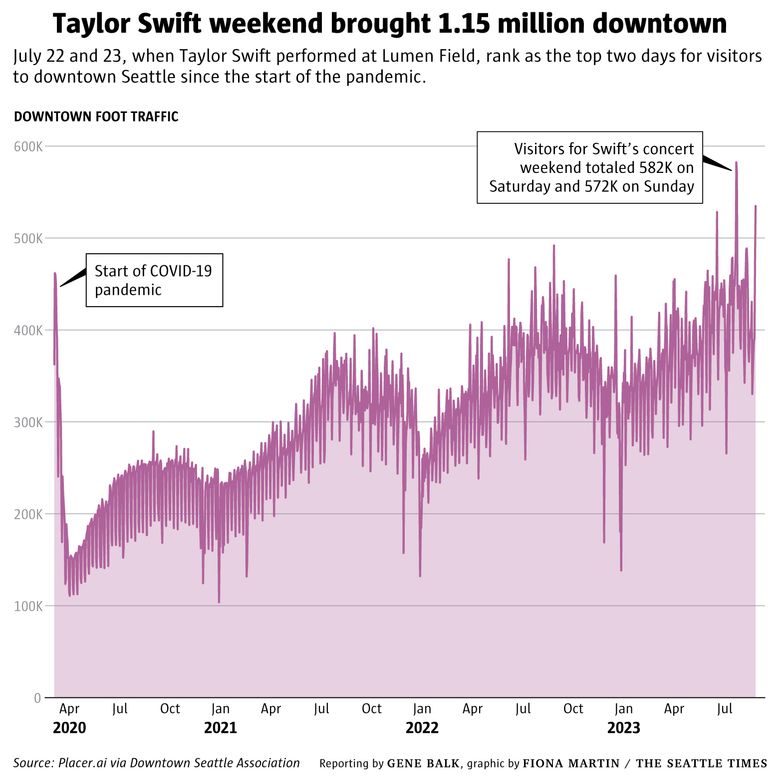News
The Seattle Times: Seattle’s top data stories of 2023
Posted on

This story was originally published in The Seattle Times on Jan. 1, 2024
Data can tell the story of a city and a region.
Looking back over a year’s worth of FYI Guy columns, a handful jumped out at me as particularly illustrative of Seattle in 2023. A few addressed lingering questions about the city’s recovery from the pandemic. Others stood out because of the strong response they evoked from readers.
One column did both.
Seattle booming again, but with a twist
In May, I wrote about new data from the U.S. Census Bureau showing Seattle was once again the nation’s fastest-growing big city, a title we held multiple times in the 2010s.
From July 1, 2021, to July 1, 2022, Seattle saw a population gain of about 17,750 people, bringing the total to 749,000, which is a record. That penciled out to a 2.4% increase, the fastest growth among the nation’s 50 largest cities.
In May, I wrote about new data from the U.S. Census Bureau showing Seattle was once again the nation’s fastest-growing big city, a title we held multiple times in the 2010s.
From July 1, 2021, to July 1, 2022, Seattle saw a population gain of about 17,750 people, bringing the total to 749,000, which is a record. That penciled out to a 2.4% increase, the fastest growth among the nation’s 50 largest cities.
Seattle was the fastest-growing big city in 2022
Seattle’s population increased by 2.4% from 2021 to 2022, the fastest rate of growth among the 50 largest U.S. cities.

That healthy population increase was no sure thing. One year earlier, census data showed Seattle, similar to many other big cities, had lost residents as the pandemic took hold. Some other cities, including Portland and San Francisco, were still losing people last year.
But while Seattle’s population increased, other census data showed that our region’s pattern of growth had changed.
King County and the Greater Seattle area only grew in 2022 because of people moving here from other countries and “natural increase” (more births than deaths). In a reversal from most of the 2010s, the region had negative net domestic growth — in other words, the number of people who moved away was higher than the number who moved here from other parts of the United States. This change might have an effect on Seattle’s population growth in the coming years.
Seattle grew in its Seattle-ness
Data released last year showed a few of the things that have long made Seattle stand out from the rest of the nation became even more pronounced in 2023.
For example, the Seattle area became even more of a “blue bubble” than it had been. In an October column, I wrote about data from market-research giant Nielsen showing in the 2022-2023 period, 55% of adults who live in King and Snohomish counties said they are Democrats or lean Democratic — a projected 1.4 million people out of the 2.5 million total population in the two counties.
That represents a significant increase from the first time Nielsen published political-affiliation data for this area. In the 2004-2005 period, 44% of adults in King and Snohomish counties identified as Democrats or leaned Democratic.
This data seems to suggest a reshuffling of the population along political lines. It’s likely that a high percentage of the new arrivals to the Seattle area are liberal. It’s also possible that many conservative residents moved away. Indeed, some evidence shows that Americans are moving to areas that align better with their politics, making blue areas bluer and red areas redder.
As Seattle got bluer, it also saw a sharp rise in the number of tech workers. In a September column, I wrote about census data from 2019 to 2022 showing that the estimated number of Seattle residents employed in a computer or mathematical occupation increased by 10,000, hitting a record 68,700. That’s equal to 15% of Seattle’s employed population in 2022, a higher percentage than any of the 50 largest U.S. cities — significantly higher than even San Francisco or San Jose, both at 11%.

For many years, Seattle has ranked among the nation’s most highly educated cities, something that’s a point of civic pride. But new census data showed we hit a record for college grads in 2022, which made me wonder if it’s possible for the city to be overeducated.
In an October column, I wrote about census data showing nearly 385,000 Seattle residents had a bachelor’s degree or higher in 2022, representing 67% of the city’s 25-and-older population.
It is a remarkable increase.
Ten years earlier, in 2012, 56% had a college diploma. Among the 50 largest U.S. cities, Seattle ranked No. 1 in 2022 for the share of population that had graduated from a four-year college.
The state of downtown Seattle
It was another challenging year for downtown Seattle, with its spotty recovery from the pandemic, but I thought it was important to also recognize the successes.
I wrote how Taylor Swift’s back-to-back concerts at Lumen Field in July brought 1.15 million people downtown, the biggest crowds since the start of the pandemic.

I also shared data published by the Downtown Seattle Association that showed worker foot traffic this spring finally surpassed 50% of downtown’s prepandemic levels — it was the first time that had happened since offices shuttered in the early part of 2020.
According to the Downtown Seattle Association, the average number of weekday workers downtown in June was 86,444 — that’s 54% of the average from June 2019, which was 160,153.
Through the most recent data for November, the numbers haven’t changed much.
The challenges remain. Demand for downtown office space was in something of a free-fall at only 21% of the prepandemic level when I checked in November. And in May, I looked at data comparing the recoveries of 63 large North American cities based on the amount of smartphone activity downtown compared with 2019 levels. Seattle ranked 51st.
Here’s hoping for some positive data on downtown’s recovery in 2024. I’ll be keeping my eye on that, and whatever else data may tell us about the Seattle area in the new year.